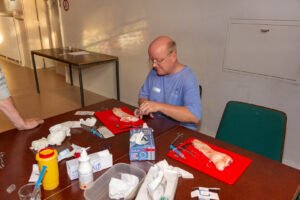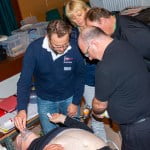First Aid and Medical Manuals

This page includes links to first-aid and medical manuals. First aid, as taught in most courses (particularly those for driving licenses and as an office first-aider), is geared towards keeping an injured person alive and stabilised long enough for professionals to get there. In a typical urban setting, this can take as little as 10-15 minutes.
But when sailing, even close to shore, the requirements are very different. There is no quick ambulance service. There’s no doctor or medic available on short notice. In an emergency, one is left to one’s own devices and whatever supplies are available on board.

The goal is the same: to keep someone alive or prevent deterioration of their condition until help arrives or they can reach help. But the short timeframe for getting to a professional has now expanded from minutes or hours to days, and in dire cases, even weeks.
Books

While I can’t recommend taking an outdoor first-aid course or a marine offshore course strongly enough, there’s a lot that can be done with a good medical cabinet and the information in the PDFs and books listed below. World Sailing has a list of specifications for its certification.
The first-aid and medical manuals cover a wide range of possible injuries aboard. Some of the information, such as dealing with gunshot trauma, is less likely to be used, but the treatment of injuries is well-covered and the Where There is no Doctor PDF files are great at helping to diagnose less obvious problems.
- Where there is no Doctor, 2010 version
- Where there is no Doctor, 2011 version
- Special Operations Forces Medical Handbook
- First Aid - Headquarters, Departments of the Army, the Navy, and the Air Force
- The Ship's medicine chest and medical aid at sea
- Ethicon Wound Closure Manual
- Health Effects of Permethrin-Impregnated Army Battle-Dress Uniforms
- World Health Organization Model List of Essential Medicines
- WHO International Medical Guide for Ships
- Vendee Globe Medical Kit
